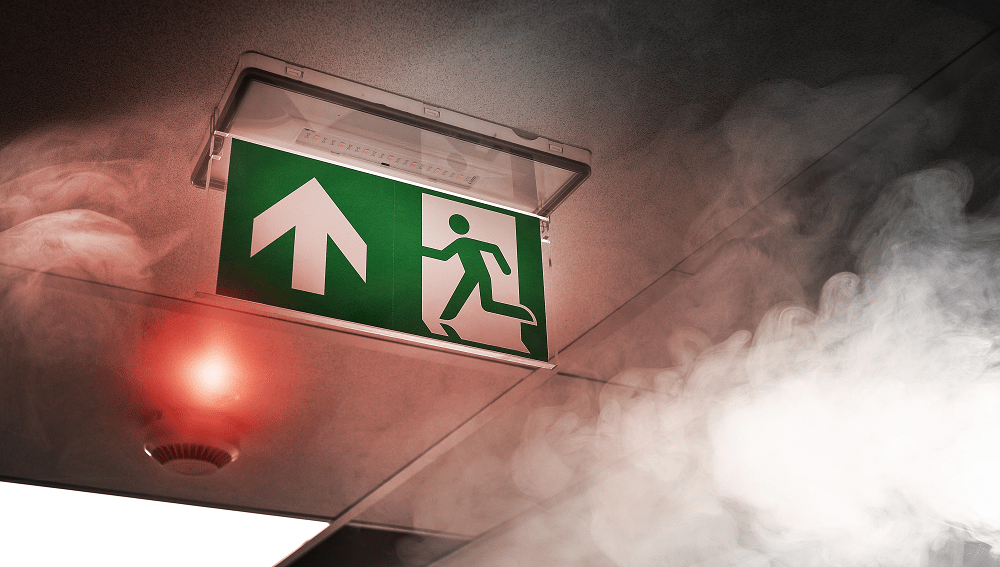How to effectively prevent fires by the use of modern ventilation systems

Stairways – escape route and smoke exhaust systems.
Most of us assume that fires do not concern us, and will not happen during our work or in our office. We believe that the only time we’ll have to deal with a fire in an office building or in the workplace is during OHS training. However, it’s not just theory and a regular topic of training, but also an important warning.
Autor

Monika Heba
Content & Social Media Specialist – SMAY
A workplace fire hazard is present not only where activities with a high fire risk are carried out, but also in offices, shops or plants that do not come into contact with open sources of fire or sparks on a daily basis. For this reason, the applicable Regulation of the Minister of Infrastructure of April 12, 2002 on technical conditions to be met by buildings and their location, requires the use of appropriate fire protection solutions. These enable us to avoid fire in the workplace or to quickly and effectively extinguish the fire, if it does occur.
Fire statistics
• In Poland, more than 27,000 domestic fires break out annually.
• Every year, about 500 people die in fires.
• 95% of the victims are poisoned by gases.
• 70% of the victims suffer a fire at night.
• More than 4,000 people are injured as a result of these fires.
• Property losses resulting from fires are estimated at 1.3 billion Polish zloty per year1.
• Smoke detectors reduce the number of fire victims by about 50%.
Electrical installations and faulty electrical appliances accounted for 19.58% of the causes of all fires between 2000 and 2019. Despite a significant decrease in 2014 and a slight decrease in the last few years, the percentage of fires caused by faulty electrical installations or appliances remains high.
The figures above apply to fires caused by electrical installation in buildings. They are based on selected statistics from the Main Headquarters of the State Fire Service2.
How a fire occurs
The most common causes of fires are:
• arson,
• improper handling of fire,
• leaving an open fire unattended,
and in addition:
• improper organisation at work, e.g. lack of supervision, lack of no-smoking signs,
• lightning – lack of lightning protection or the wrong type,
• static electricity – no grounding,
• improper use of electrothermal equipment,
• improper use of chimney flues,
• carelessness during fire-hazardous work – welding, cutting, heating of materials,
• defects or improper use of electrical equipment – overloads, short circuits, electric arc,
• chemical reactions resulting from the relationship of the materials,
• chemical reactions in technology and storage and the mixing of flammable liquids,
• mechanical – improper operation of devices and machines – friction of elements, mechanical sparks.

Fires can have different causes. As we can see, the human factor is often to blame, and in such cases the most common cause is negligence. We say that such a fire is anthropogenic, i.e. related to human activity. Very often, a fire is a consequence of defects in electrical devices (e.g. short circuits). Many installations are made of aluminium, and their protection is often faulty or incorrectly selected.
Escape route from fire
The natural escape route at the time of a fire is a staircase – usually it is the only life-saving option. In accordance with health and safety rules, employees should leave the building via a properly-marked evacuation route, prepared for this very purpose.
What requirements apply to a stairway?
According to the Regulation of the Minister of Infrastructure of 12 April 2002 on the technical conditions to be met by buildings and their location:
- Stairways and fire vestibules constituting an escape route in a tall building from fire zones other than ZL IV and PM and in a high-rise building, shall be equipped with devices to prevent them becoming smoke-filled.
- Stairways and fire vestibules constituting an escape route in a tall building from the PM fire zone, shall be equipped with smoke prevention devices or automatic smoke extraction devices activated by means of a smoke detection system.
Care should be taken to ensure that escape routes remain clear and unobstructed. In public corridors and stairways, it is forbidden to collect or store large objects such as bicycles and furniture, as well as books or other combustible materials. They make evacuation difficult, and if a fire reaches them, they will accelerate its spread and become a source of poisonous gases and very high temperatures. Safe evacuation should be planned in advance; make sure everyone knows how to leave the danger areas.
Effective ventilation ensures much greater safety
According to Brig. Karol Kierzkowski (spokesperson for the chief commander of the State Fire Service), fewer fires break out in public buildings, including offices, than in flats and private houses. Effective safeguards, i.e. proper ventilation and detectors, help to safely prevent fire-related tragedies. In the tables below, we present fire statistics collating injuries and fatalities in various types of facilities during 2021.
Table 1. Statistics relating to offices, public buildings, garages and other facilities that are not flats or houses
| Buildings | Fires
|
| administrative/office, banks | 275 |
| education and learning, in particular teaching buildings, schools, nursery schools | 207 |
| health services, in particular hospitals, sanatoriums, nursing homes, clinics, crèches | 277 |
| retail and service establishments, in particular shops, department stores, restaurants, wholesalers, service centres | 1006 |
| passenger transport services, in particular railway and bus stations, river and sea ports, airports | 36 |
| entertainment and sports | 98 |
| other public facilities | 210 |
| hotels, accommodation | 354 |
| orphanages | 13 |
| dormitories, student halls | 273 |
| barracks | 0 |
| retirement homes | 7 |
| holiday homes, pensions | 63 |
| hostels | 18 |
| social areas, in particular cloakrooms, canteens | 39 |
| free-standing garages and car workshops, including garage complexes | 1175 |
| garages and car workshops located within residential buildings | 146 |
| garages and car workshops located inside other buildings or parts thereof, classified as a danger to people | 34 |
Table 2. Statistics concerning houses and flats
| Houses and flats | Fires |
| single-family, including semi detached, terraced houses | 18760 |
| multi-family | 11081 |
| residential buildings on a farm holding | 2243 |
| other residential facilities, in particular gazebos, barracks, summer houses | 1530 |
| industrial buildings | 923 |
| industrial buildings (including shelters, no garages) | 1049 |
Ventilation systems ensure safety and protect against fire or minimise damage. Therefore, it is well worth knowing more about them and taking care over their installation not just in public buildings.
SMAY, a manufacturer of ventilation systems, provides protection for people and possessions in buildings in the event of a fire.
Industrial ventilation systems and devices can be divided according to the function they are to perform in the building. The SMAY company offers a complete range of devices whose task is, firstly, to extract smoke and heat from the zones affected by the fire, secondly to remove contaminants (harmful substances), and thirdly overpressure protection of fire escape routes.
ZODIC systems are complete sets of devices for removing smoke and heat from stairways. They ensure an appropriate level of human safety and conditions for evacuation, firefighting and rescue operations. These systems:
- increase the level of human safety through a higher standard of building safety,
- improve conditions of the building, enabling the extension of evacuation routes in the building,
- are an alternative to smoke prevention systems for stairways (the so-called overpressure systems).
Smoke extraction systems are divided into:
- The ZODIC-G smoke extraction system with gravitational inflow of make-up air,
- The ZODIC-M smoke extraction system with make-up air supplied mechanically.
General characteristics of the ZODIC-G gravity system
- The system removes smoke from the stairway by making use of the natural flow of air and smoke, caused by the stack effect and thermal stratification of smoke during a fire.
- Make-up air enters by the automatic opening of either a door to the stairwell on the ground floor, or a window or by means of a wall intake.
General characteristics of the ZODIC-M mechanical supply-air support system
- The system extracts smoke through the mechanically-enforced flow of air and smoke through the stairway.
- Make-up air is brought in through mechanical ventilation to the lower part of the stairway (fans with variable and adjustable air flow).
- Through the use of mechanical ventilation installations, the impact of natural phenomena shaping the flow of air and smoke on the efficiency of smoke extraction in the stairway is limited.
Photo 1. The ZODIC-G System

Smoke extraction of the stairway based on fire simulation
Fire can be tested, that is, a fire simulation can be carried out, which gives us valuable knowledge on how to effectively protect people, extinguish the fire and efficiently clear the room of smoke.
The ZODIC-M system was created thanks to research conducted in real fire conditions as part of the “Safe Evacuation” project. The aim of the project was to check whether the staircase protection systems commonly used in Poland are effective and ensure an adequate level of safety for people in buildings as well as conditions for evacuation and firefighting operations. This is the first project of this type in Poland and one of the few in Europe on such a scale.
As part of the project, six fires and about 80 fire tests were carried out in a multi-storey building found specifically for the project. More than 100 people took part in the project: construction workers, fire ventilation designers, analysts and independent experts, firefighters and university employees, organisers.
The summary of this research was presented during the “Safe evacuation” conference, which took place in the Expo Silesia hall in Sosnowiec on June 2, 2016. During the meeting, the participants could see with their own eyes one of the fire tests in the test building.
Details of the project are available on the website https://www.bezpiecznaewakuacja.pl.
Photo 2. System ZODIC-M

Examples of designing smoke exhaust systems for stairways and more practical tips are available in the ZODIC smoke extraction systems design guide.
- Source: Building fires statistics, elektro.info.pl [online], May 4, 2020 [access: March 22, 2022]. Available on the Internet: https://www.elektro.info.pl/artykul/ochrona-ppoz/157443,statatyki-pozarow-budynkow.
- Source: website of the National Headquarters of the State Fire Service [online; access: March 17, 2022]. Available on the Internet: www.kgpsp.gov.pl.



